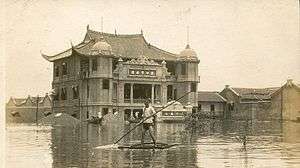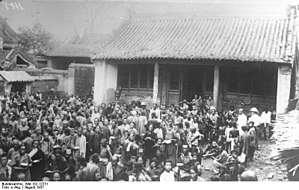1931 China floods
The 1931 China floods, or the 1931 Yangtze–Huai River floods, were a series of devastating floods that occurred in the Republic of China. They were some of the deadliest floods in history, and together formed one of the most lethal natural disasters of the 20th century.[3] Estimates of the total death toll range from 422,499[4] to as many as 3.7 million to 4 million people, especially Tanka people, may have died as a result of famine and disease caused by the flood.[5][6][7]
 Hankou city hall during the 1931 flood | |
| Date | July–November 1931 (depending on river) |
|---|---|
| Location | Central and eastern China |
| Deaths | 422,499-4,000,000[1][2] |
Meteorological causes and physical consequences
From 1928 to 1930 , China was afflicted by a long drought.[6] The subsequent winter of 1930 was particularly harsh, creating large deposits of snow and ice in mountainous areas. Early 1931, melting snow and ice flowed downstream and arrived in the middle Yangtze during a period of heavy spring rain. Ordinarily, the region experienced three periods of high water during the spring, summer and autumn; early 1931 there was a single continuous deluge. By June, those living in low areas had already been forced to abandon their homes.[3] The summer was also characterized by extreme cyclonic activity. In July of that year alone, nine cyclones hit the region, which was significantly above the average of two per year.[8] Four weather stations along the Yangtze River reported rain totaling over 600 mm (24 in) for the month.[8] The water flowing through the Yangtze reached its highest level since record-keeping began in the mid-nineteenth century. That autumn, further heavy rain added to the problem and some rivers did not return to their normal courses until November.[3]
The floods inundated approximately 180,000 km2 – an area equivalent in size to England and half of Scotland, or the states of New York, New Jersey and Connecticut combined.[9] The high-water mark recorded on 19 August at Hankou in Wuhan showed water levels 16 m (53 ft) above the average, an average of 1.7 m (5.6 ft) above the Shanghai Bund.[1][10] In Chinese, this event is commonly known as 江淮水灾, which roughly translates to "Yangtze-Huai Flood Disaster." This name, however, fails to capture the massive scale of flooding. Waterways throughout much of the country were inundated, particularly the Yellow River and Grand Canal. The eight most seriously affected provinces were Anhui, Hubei, Hunan, Jiangsu, Zhejiang, Jiangxi, Henan and Shandong. Beyond the core flood zone, areas as far south as Guangdong, as far north as Manchuria, and as far west as Sichuan were also inundated.[4][3]
Death toll and damage

At the time the government estimated that 25 million people had been affected by the flood.[9] Historians since have suggested that the true number may have been as many as 53 million.[4] Estimated death tolls also vary widely. Contemporary studies conducted by John Lossing Buck allege that at least 150,000 people had drowned in the first few months of the flood, with hundreds of thousands more dying of starvation and disease over the following year. Using contemporary media reports, Chinese historians led by Li Wenhai have calculated the death toll at 422,499.[4] Some Western sources allege that death toll of between 3.7 and 4 million people based on their own claims of famine and disease.[5][6] The Tanka people who traditionally live on boats among the Yangtze suffered greatly from the flooding.
The flood destroyed huge amounts of housing and farmland.[9] Throughout the whole Yangtze Valley around 15% of the wheat and rice crops were destroyed, with the proportion being much higher in the flood affected areas.[11] The disaster also caused an economic shock with the price of vital commodities rising rapidly. The combined ecological and economic impacts of the disaster caused many areas to descend into famine. With no food, people were reduced to eating tree bark, weeds, and earth. Some sold their children to survive, while others resorted to cannibalism.[1][3] The most lethal effect of the flood was the diseases that swept through the refugee population due to displacement, overcrowding, and the breakdown of sanitation. These included cholera, measles, malaria, dysentery, and schistosomiasis.[3]
As well as inundating rural areas, the flood caused widespread destruction to a number of cities. Refugees had been arriving in the city of Wuhan since the late spring. When the city itself was inundated in the early summer and after a catastrophic dike failure at just before 6:00 AM on July 27,[12]:270 around 782,189 urban citizens and rural refugees were left homeless. The flood covered an area of 32 square miles and the city was flooded under many feet of water for close to three months.[12]:269-270 Large numbers gathered on flood islands throughout the city, with 30,000 sheltering on a railway embankment in central Hankou. With little food and a complete breakdown in sanitation, thousands soon began to succumb to diseases.[3]
There was no warning, only a sudden great wall of water. Most of Wuhan's buildings in those days were only one story high, and for many people there was no escape- they died by the tens of thousands. ... I was just coming off duty at the company's main office, a fairly new three-story building near the center of town ... When I heard the terrible noise and saw the wall of water coming, I raced to the top story of the building. ... I was in one of the tallest and strongest buildings left standing. At that time no one knew whether the water would subside or rise even higher.
The city of Nanjing, then the capital of Republican China, was also severely affected by the disaster.[1] One of the most disastrous single events during the flood occurred on 25 August 1931, when the water rushing through the Grand Canal washed away dikes near Gaoyou Lake. In Gaoyou County alone, 18,000 people drowned and 58,000 died due to famine and diseases the following year.[13]
Government reactions
Republic Era (1930s–1940s)
The 1931 flood was one of the first major tests for the Kuomintang Government. As the scale of the disaster became apparent, the government established the National Flood Relief Commission under the auspices Song Ziwen (T.V. Soong), a prominent politician in the Kuomintang and brother-in-law of Chiang Kai-shek.[9] The commission employed a range of Chinese and foreign experts, including figures such as the famous epidemiologist Wu Liande, the health minister Liu Ruiheng, the public health worker John Grant, and the hydraulic engineer Oliver Todd. It also secured the assistance of the League of Nations. Even the famous aviators Charles Lindbergh and his wife Anne Lindbergh became involved, as they were commissioned to conduct an aerial survey of the flood zone. Although Song Ziwen remained the head of the Commission, the day-to-day running the relief effort was entrusted to John Hope Simpson, a British refugee expert. Charity poured in to help with the relief effort from throughout the world, with overseas Chinese communities in Southeast Asia being particularly generous. In the United States, the celebrated author Pearl Buck wrote short stories to encourage charitable donations. The relief effort become much more difficult following the Japanese invasion of Manchuria in the autumn of 1931, which caused the Chinese bond market to collapse. Eventually, the government managed to secure a large loan of wheat and flour from the United States.[3] In the wake of the disaster, the government set up organizations such as the Huai River Conservancy Commission to address flood problems.[1] However, due to a lack of funding and the chaos of the Second Sino-Japanese War and the subsequent Chinese Civil War, the various commissions were only able to construct small dams along the Yangtze River.[14]
As part of an anti-superstition campaign by the Kuomintang Government, a Dragon King Temple was demolished in Wuhan shortly before the flood hit. This coincidence led to widespread discontent afterwards, as many locals linked the disaster to the anger of Dragon King, a rainmaking deity. As a response, prominent officials, including He Baohua, mayor of Wuhan, and Xia Douyin, then the local garrison commander and later governor of Hubei Province, held ritual ceremonies and kowtowed to the deity. Meanwhile, many believed that evacuation efforts were hindered by superstition. According to a contemporary report, thousands "are convinced that Hankow is doomed and refuse to help themselves or be helped. They sit stoically awaiting death."[15]
Communist Era (1949–present)
In 1953, after the end of the Civil War, Chinese Communist Party leader Mao Zedong travelled to the Yangtze River to promote the Three Gorges Dam flood control project. "The Socialist Three Gorges Dam project should excel other major projects in Chinese history such as Qin Shi Huang's Great Wall and Sui Yang Di's Grand Canal", he stated.[14]
Scientists and officials who raised doubts, such as Chen Mingshu, were persecuted as rightists. Li Siguang, a prominent scientist and minister of geological resources, told Mao he would commit suicide if he could not stop the construction of the dam.[14] The project did not move beyond the planning stage in Mao's time, due to a lack of resources, rising Sino-Soviet tensions and the disruptions of the Great Leap Forward.[14] The project was restarted in the 1980s, and the hydroelectric Three Gorges Dam began full operation in 2012, becoming the world's largest power station in terms of installed capacity at the time.[16]
See also
- 1887 Yellow River flood
- 1938 Yellow River flood
- 1998 China floods
- List of deadliest floods
- List of deadliest natural disasters
- Natural disasters in China
References
- Pietz, David (2002). Engineering the State: The Huai River and Reconstruction in Nationalist China 1927–1937. Routledge. ISBN 0-415-93388-9. pp. xvii, 61–70.
- https://www.livescience.com/33316-top-10-deadliest-natural-disasters/2.html
- Chris Courtney (2018). The Nature of Disaster in China: The 1931 Yangzi River Flood. Cambridge University Press. ISBN 978-1-108-41777-8.
- 李文海 (1994). 中國近代十大灾荒. 上海人民出版社. ISBN 9787208018129.
- "Dealing with the Deluge". PBS NOVA Online. 26 March 1996. Retrieved 12 February 2013.
- Glantz, Mickey. Glantz, Michael H (2003). Climate Affairs: A Primer. Island Press. ISBN 1-55963-919-9. p. 252.
- "NOAA'S top global weather, water and climate events of the 20th century". NOAA.gov. 13 December 1999. Retrieved 29 November 2012.
- National Flood Relief Commission Report of the National Flood Relief Commission Shanghai, 1932
- Winchester, Simon (2004). The River at the Center of the World: A Journey Up the Yangtze, and Back in Chinese Time. Macmillan. ISBN 0-312-42337-3.
- Y.Y. Kueh Agricultural Instability in China, 1931–1990: Weather, Technology, and Institutions Oxford University Press, 1995,ISBN 0-19-828777-1
- William Graves (1982). The Torrent of Life (Journey into China) (5th ed.). National Geographic Society. ISBN 978-0-87044-437-1.
- "被遗忘的1931年中国水灾" (in Chinese). Tsinghua University Institute of Qing History. Retrieved 20 January 2019.
- Li, Cheng & Barnett, Arthur Doak (1997). Rediscovering China: Dynamics and Dilemmas of Reform. Rowman & Littlefield. ISBN 0-8476-8338-9. pp. 168–169.
- Courtney, Chris (2015). "The Dragon King and the 1931 Wuhan flood: religious rumors and environmental disasters in republican China". Twentieth-Century China. 40 (2): 83–104. doi:10.1179/1521538515Z.00000000059.
- "Breathtaking force: World's most powerful dam opens in China as gushing water generates the same power as fifteen nuclear reactors". The Daily Mail. 25 July 2012. Retrieved 13 September 2012.
External links
- "The 1931 Central China Flood" DisasterHistory.Org (English and Chinese Versions)
- "An Analysis of Flood and Social Risks Based on the 1931 Changjiang & Huai River Flood During the Republic of China". ILIB.cn.
- "Extremely heavy meiyu over the Yangtze and Huaihe vaneies in 1931" 1931年江淮异常梅雨 (in Chinese). CQVIP.com.